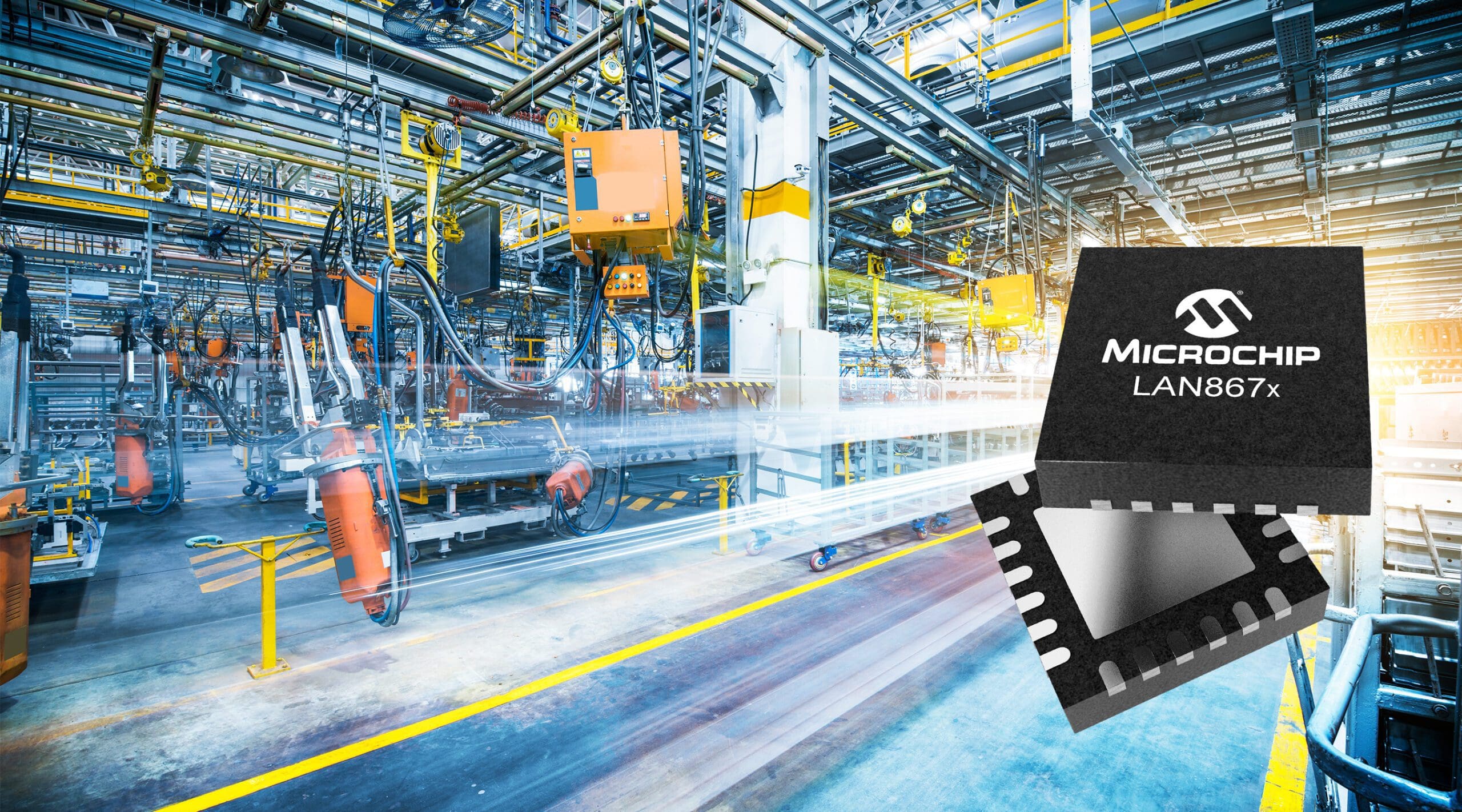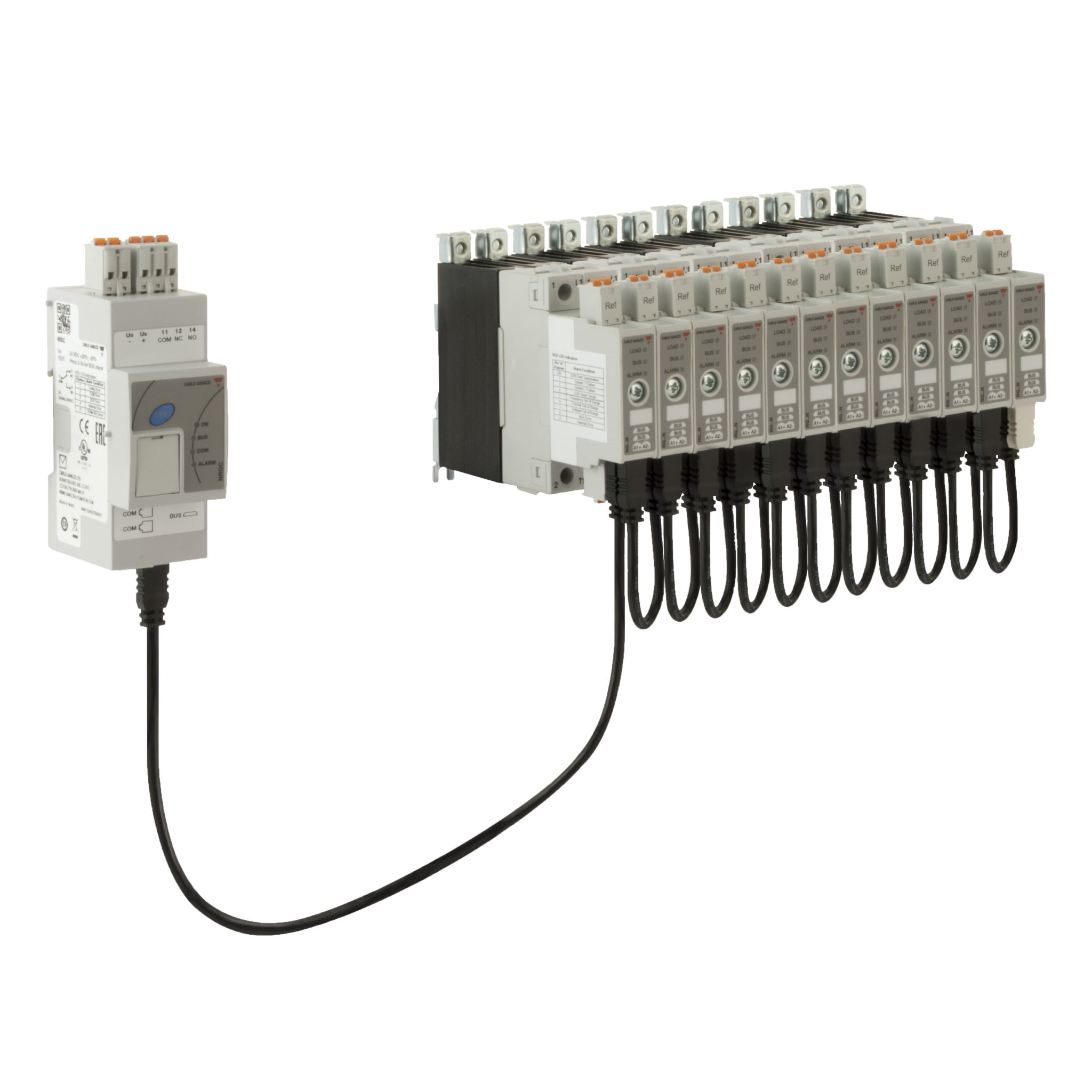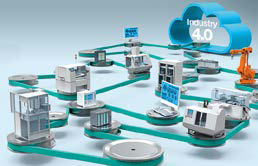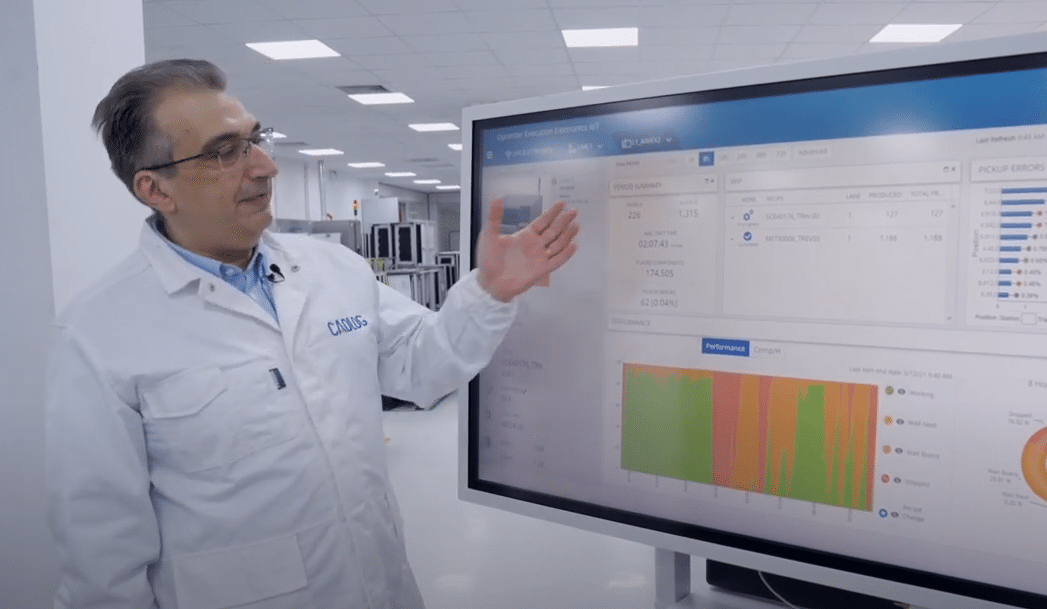Connecting manufacturing facilities to the Internet increases efficiency, quality, and productivity. For example, machines can be remotely programmed and controlled, data from machines and processes can be continuously analyzed for errors or process deviations, and remote adjustments can be made to fine-tune production in a closed feedback loop. In the long term, the data can be used to plan for future expansion and faster integration of new manufacturing techniques.
Although the arguments in favor of connectivity are strong, how that connectivity is achieved requires serious consideration. There are many options, but Ethernet offers an affordable and proven solution for the factory network. It is the most widely used cable network option, globally, with good support from providers and seamless interoperability with the cloud. Best of all, cabling can be used to carry power (Power over Ethernet (PoE)) and data, which means that one set of cables can support the network and power connected sensors, actuators, and other devices such as cameras. .
However, standard Ethernet is not up to the industrial job. The hardware is not designed to function reliably in a hot, dirty, and vibration-prone factory environment. In addition, standard Ethernet protocols are not deterministic and therefore not suited to the needs of the factory environment, where production requires near real-time control to manage high-speed processes.
Industrial Ethernet brings all the benefits of standard Ethernet, but adds resiliency and deterministic software to the mix. It is a proven and mature technology for industrial automation, which not only allows process data to be sent to the cloud, but also drives, PLCs and I/O devices can be easily accessed by a remote supervisor on the go. the manufacturing plant. A modification of the Ethernet standard, IEEE 802.3cg, uses a single pair of wires to transport data, reducing the bulk and cost of factory wiring.
This article discusses the connectivity challenge in industrial applications before discussing the differences between Ethernet and Industrial Ethernet. The article then considers the use of PoE and Single Pair Ethernet (SPE) technologies before presenting the actual Amphenol hardware, and how it can be implemented in an Industrial Ethernet network.
Ethernet challenges for industry
Although Wi-Fi is the most popular way for consumers to connect to the Internet, businesses often use Ethernet cable Local Area Network (LAN) technology to connect computers and other equipment.
In the early days of Ethernet, computers on the network used a single bus to communicate. This type of network is the simplest configuration and is cheap and easy to install. However, it is relatively inefficient because connected computers compete for bandwidth, leading to congestion, packet loss, and a noticeable reduction in bandwidth.
Today's office networks often use star, tree, or mesh topologies where switches control access to the network to limit congestion and maintain performance. Ethernet traffic is controlled by the switches so that direct messages go only between the devices that need to communicate, rather than being broadcast throughout the network (Figure 1).
 Figure 1: Ethernet switches control network access to limit congestion and maintain performance. (Image source: Amphenol)
Figure 1: Ethernet switches control network access to limit congestion and maintain performance. (Image source: Amphenol)
Based on a continually updated standard (IEEE 802.3), Ethernet is proven, secure, reliable, and offers transmission speeds of up to hundreds of gigabytes (Gbytes). Although not part of the standard, Ethernet typically uses TCP/IP (part of the Internet Protocol (IP) suite) for routing and transport, allowing seamless connectivity to the Internet. It also allows networks to be easily expanded with cables, connectors, and switches available from hundreds of vendors.
Ethernet has evolved to combine power and communications over a single CAT 3 or CAT 5 Ethernet cable, allowing engineers to build low-maintenance Ethernet and power networks quickly and inexpensively, compared to installations that use separate systems. The technology has been formalized under an Institute of Electrical and Electronics Engineers (IEEE) standard called PoE. The main advantages of this technology are its simplicity and the fact that energy is available wherever there is a data collection. (See «Introduction to Power over Ethernet").
A recent amendment to the Ethernet specification, IEEE 802.3cg, describes the SPE alternative for transporting data over a single pair instead of the multi-span CAT 3 or CAT 5 cable of standard Ethernet or PoE. The SPE is well-suited for industrial automation applications because it enables designers in the factory and building automation markets to use popular Ethernet-based protocols for long-distance communication between controllers and industrial sensors, while significantly reducing the volume of wiring (Figure 2).
 Figure 2: Single-pair Ethernet is emerging as a space-saving and cost-effective form of Ethernet for a number of industrial and commercial applications. (Image source: Amphenol)
Figure 2: Single-pair Ethernet is emerging as a space-saving and cost-effective form of Ethernet for a number of industrial and commercial applications. (Image source: Amphenol)
In principle, Ethernet represents an ideal way to link a supervisory office to the manufacturing operation, effectively bridging the gap between information technology (IT) and operational technology (OT) networks.
Manufacturing facilities present an additional engineering challenge when implementing Ethernet. First, factories are a dangerous environment for delicate cables, connectors, and switches. The environment is hot, dusty, and full of chemicals that are incompatible with the 100+ meter cable runs typical of factory deployments. Also, moisture and vibrations play havoc with conductors and contacts. In addition, factories are full of large motors that are constantly turning on and off, causing voltage transients and electromagnetic interference (EMI) that can disrupt Ethernet communications.
Second, a manufacturing facility is full of fast-moving robots and synchronized machines that need real-time control. Standard Ethernet non-deterministic communication mechanisms are not prepared to provide this control capability.
Industrial Ethernet Hardware
"Industrial Ethernet" is the common term for Ethernet systems adapted for use in factories. These systems are characterized by their robust physical layers (PHY) and industrial protocols such as ModbusTCP, PROFINET and Ethernet/IP. Also, unlike standard Ethernet implementations, Industrial Ethernet typically uses line or ring topologies because they help shorten cable runs (limiting the impact of EMI), reduce latency, and add some degree of redundancy.
The cables are rugged and include shielding to protect them from EMI, and the connectors are equally protected against the rigors of an industrial environment.
Manufacturers classify the resistance of their products according to the IP rating system. The IP classification indicates the degree of protection offered by the product and is defined by the international standard EN 60529. The scheme consists of two digits. The first represents the level of protection against solid objects, from tools or fingers that could be dangerous if they encountered electrical conductors, to airborne dirt and dust that could damage circuitry. The second digit defines protection against dripping water, splashing or immersion. The range extends from IP00 (no protection against dust or water) to IP69 (full protection against dust and powerful high-temperature water jets).
Industrial Ethernet connectors are typically enclosed in a range of protective housings up to IP67. In this case, a rating of six means no harmful dust or dirt will seep into the unit even after eight hours of direct contact with contamination. A water protection rating of seven means the device can be submerged in up to one meter of fresh water for 30 minutes without damage.
When selecting PHYs, cables, and connectors for Industrial Ethernet, the designer must verify immunity to electromagnetic interference (EMI) by examining the data sheet for the following IEC and EN standards:
- IEC 61000-4-5 surge voltages
- IEC 61000-4-4 Electrical Fast Transient (EFT)
- IEC 61000-4-2 ESD
- Conducted immunity IEC 61000-4-6
- EN 55032 radiated emissions
- EN 55032 conducted emissions
Compliance with some or all of these standards ensures that the performance of the Industrial Ethernet system in the factory environment will be satisfactory.
reinforced connectors
Whether they are built into machine control panels, Ethernet switches, or cabling, connectors are vital to the performance of the Industrial Ethernet system. Without careful selection, the failure of a single connector under the stress of high-speed production can cause million-dollar machines to malfunction or stop.
There are several vendors that offer proven and reliable Industrial Ethernet connectors for a variety of Ethernet, PoE and SPE applications. For example, Amphenol's IP6X rectangular connectors and cables solution provides CAT 6A Ethernet connectivity using the IEC 61076-3-124 mating interface and full sealing to IP65, IP66 and IP67 specifications. In particular, the connectors are intended for use in Industrial Ethernet applications that require additional environmental protection and are suitable for any rugged or harsh environment, both indoors and outdoors.
The family includes the NDHN200 IP67 rectangular panel mount connector housing shown in Figure 3. The multi-purpose, solderless NDHN3A2 10 position connector (Figure 4) is designed to mate with the NDHN200. The plug connector includes a latch closure and shield molding. It is rated at 50 volts AC or 60 volts DC, 1.5 amps (A), and can be engaged/disengaged up to 250 times.
 Figure 3: The NDHN200 is an IP67-rated rectangular connector housing for Industrial Ethernet applications. (Image source: Amphenol)
Figure 3: The NDHN200 is an IP67-rated rectangular connector housing for Industrial Ethernet applications. (Image source: Amphenol)
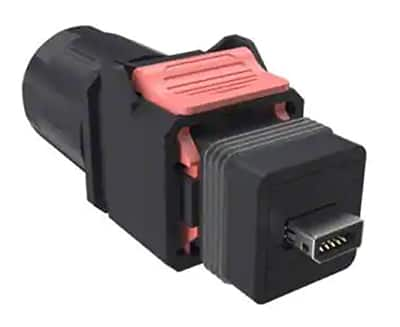 Figure 4 - The NDHN3A2 is an IP67 plug connector that includes a latch closure and shield trim. (Image source: Amphenol)
Figure 4 - The NDHN3A2 is an IP67 plug connector that includes a latch closure and shield trim. (Image source: Amphenol)
Amphenol has also released SPE connectors for Ethernet connectivity of peripheral devices such as sensors, actuators, and cameras that operate at speeds of up to one gigabit per second (Gbit/s). The SPE form factor reduces size, weight, and cost compared to standard Ethernet. The connectors have a degree of protection IP67 with a circular form factor of size M12. They mate with field-terminable plugs, providing a fully shielded interface with interlocking features. Its voltage/current handling capacity of 60 volts DC and up to 4 A supports PoE at a distance of up to 1 kilometer (km). An example is the MSPEJ6P2B02, an SPE 2P2C connector (Figure 5)
 Figure 5: The SPE IP67 MSPEJ6P2B02 connector comes in the popular circular form factor of M12 size. (Image source: Amphenol)
Figure 5: The SPE IP67 MSPEJ6P2B02 connector comes in the popular circular form factor of M12 size. (Image source: Amphenol)
The company also offers a similar range of SPE connectors with a rectangular plug format with IP20 protection rating instead of IP67. The solution offers the same electrical performance as the M12 range, but is less expensive. An example is the SPE modular connector MSPE-P2L0-2A0 (Figure 6).
 Figure 6: The SPE IP20 MSPE-P2L0-2A0 modular connector is an economical option for less hazardous environments. (Image source: Amphenol)
Figure 6: The SPE IP20 MSPE-P2L0-2A0 modular connector is an economical option for less hazardous environments. (Image source: Amphenol)
Industrial Ethernet protocols
The standard communication mechanism of Ethernet is satisfactory for the relatively quiet traffic of an office or small business. But that mechanism is susceptible to outages and packet loss, causing increased latency that makes it unsuitable for the near real-time demands of a fast, synchronized production line. As already stated, such an environment requires a deterministic protocol to ensure that instructions from the machine arrive on time, at all times, regardless of network load.
To overcome this challenge, the Industrial Ethernet hardware is complemented by equally “industrial” software. There are several proven Industrial Ethernet protocols, such as Ethernet/IP, ModbusTCP and PROFINET. Each of them is designed to guarantee the determinism of industrial automation applications.
The best way to describe the difference between Ethernet and Industrial Ethernet software is to consider the ISO/OSI seven-layer abstraction model (“stack”), comprising the PHY, data link, network, transport, and other layers. , session, presentation and application. Standard Ethernet comprises the PHY, data link, network, and transport layers (using TCP/IP or UDP/IP as transport), and can be considered a communication mechanism that provides efficiency, speed, and versatility.
In contrast, the Industrial Ethernet protocols, eg PROFINET, use the application layer of the Industrial Ethernet stack. PROFINET is a communication protocol designed for the exchange of information between machines and controllers in an automation environment, which uses the Ethernet standard as a communication mechanism (Figure 7).
 Figure 7: The ISO/OSI seven-layer abstraction model representing the Industrial Ethernet software stack. Industrial Ethernet protocols, such as PROFINET, are located in the application layer. (Image source: Profinet)
Figure 7: The ISO/OSI seven-layer abstraction model representing the Industrial Ethernet software stack. Industrial Ethernet protocols, such as PROFINET, are located in the application layer. (Image source: Profinet)
Industrial Ethernet software can also take advantage of other protocols specifically designed to send data to the cloud. Some examples are protocols like MQTT or SNMP.
Conclusion:
To account for the harsh factory environment and real-time requirements, Industrial Ethernet uses hardened hardware such as switches, cables, and connectors, as well as industrial software, to reliably connect the factory's IT and OT networks.
As demonstrated, proven commercial connector solutions make it easy for engineers to take advantage of Industrial Ethernet to program and control high-speed industrial automation, while collecting the deep data needed to improve and expand manufacturing operations.



